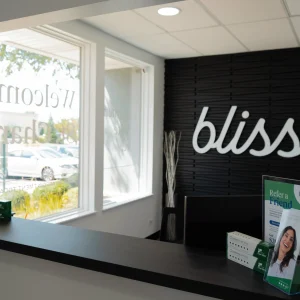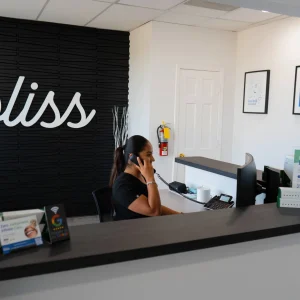Veneers in St. Charles, IL
Achieve a Stunning Transformation with Permanent Veneers
Creating a Flawless Smile: Veneers in St. Charles, IL
One of the simplest and most effective ways to improve aesthetic dental concerns is by placing porcelain veneers over the visible surfaces of your teeth. These thin, durable shells are designed to match your smile perfectly, covering up a variety of issues that might be impacting the overall appearance of your smile. At Bliss Dental, we offer personalized treatment plans and various cosmetic services to upgrade your smile and boost your confidence at the same time, including veneers, crowns, teeth whitening, bridges, and more.
- Cover Up Cosmetic Concerns: What are the main aesthetic issues that are affecting your confidence? We offer natural-looking veneers that correct common issues such as discoloration, chips, cracks, gaps, and small misalignment concerns.
- Long Lasting Treatment: Veneers are durable and strong, giving you the long-lasting results that you desire. Your smile will look natural and radiant when you choose our local, experienced dental team for your veneer treatment.
- Stain Resistant: Did you know that porcelain teeth are resistant to stains? Since the visible parts of your teeth are covered by veneers, there is a lower risk of discoloration and staining.
- Customizable Results: We use Digital Smile Design that allows you to preview the appearance of your smile before beginning treatment. You have the opportunity to choose the shape, size, and shade of your new smile.
Why Bliss Dental? Experience, Technology, and Artistry
At Bliss Dental, our local dental team is highly trained in the best methods to optimize the overall results for your porcelain veneer treatment. We specialize in natural-looking veneers, and also offer full-service cosmetic treatments to help you achieve the smile that you’ve always wanted.
Not only do we use high-quality materials, but technology allows us to ensure a perfect fit. We’ll work together, using advanced digital imaging, to plan the ideal smile based on your unique needs and preferences. We ensure a comfortable and stress-free experience every step of the way. If you have questions about dental veneers or other types of cosmetic and restorative dental treatments, then schedule an appointment at our nearby office to discuss your needs.

How it works: Customized Dental Veneers in St. Charles, IL
Here are a few things that you can expect when you are getting ready for personalized dental veneers:
- Step 1 – Initial Consultation: In the beginning, we will evaluate your dental health to determine whether you are a good candidate for this treatment. We need to make sure that your teeth are healthy enough for veneers. We use Digital Smile Design to plan your treatment.
- Step 2 – Preparing Your Teeth: Now that you are ready to move forward, we prepare your teeth by removing a thin layer of enamel. This step is necessary to create space for the veneers. Digital scans are used to create the perfect fit for your smile upgrades.
- Step 3 – Final Placement: Now it’s the exciting moment when we reveal your new smile. Your custom-designed veneers are bonded to your teeth, to give you an instant smile upgrade.
Patient Stories:
Jennifer
Proudly Affiliated with Leading Dental Associations.
Our veneers process is simple:





Frequently Asked Questions
How long will my new veneers last?
If you are proactive about caring for your porcelain veneers, then they will last for 10 – 15 years, or even longer. These materials are durable and built for long-lasting results.
Will I have a natural-looking smile with porcelain veneers?
At Bliss Dental, we provide our patients with natural-looking veneers. The porcelain has the ideal translucency to mimic your natural teeth. The color, shape, and size are carefully selected to create the perfect smile for your facial features.
Are veneers a permanent treatment?
Because a small amount of enamel needs to be removed from your teeth, you will be wearing porcelain veneers for the rest of your life. If the veneers are damaged, then replacement veneers will need to be put on your teeth.
Will I be able to eat and talk normally with veneers?
Yes, veneers look and act like your normal teeth. You can enjoy your favorite foods and drinks. But we recommend that you avoid biting into hard foods because the force can damage your veneers.


























